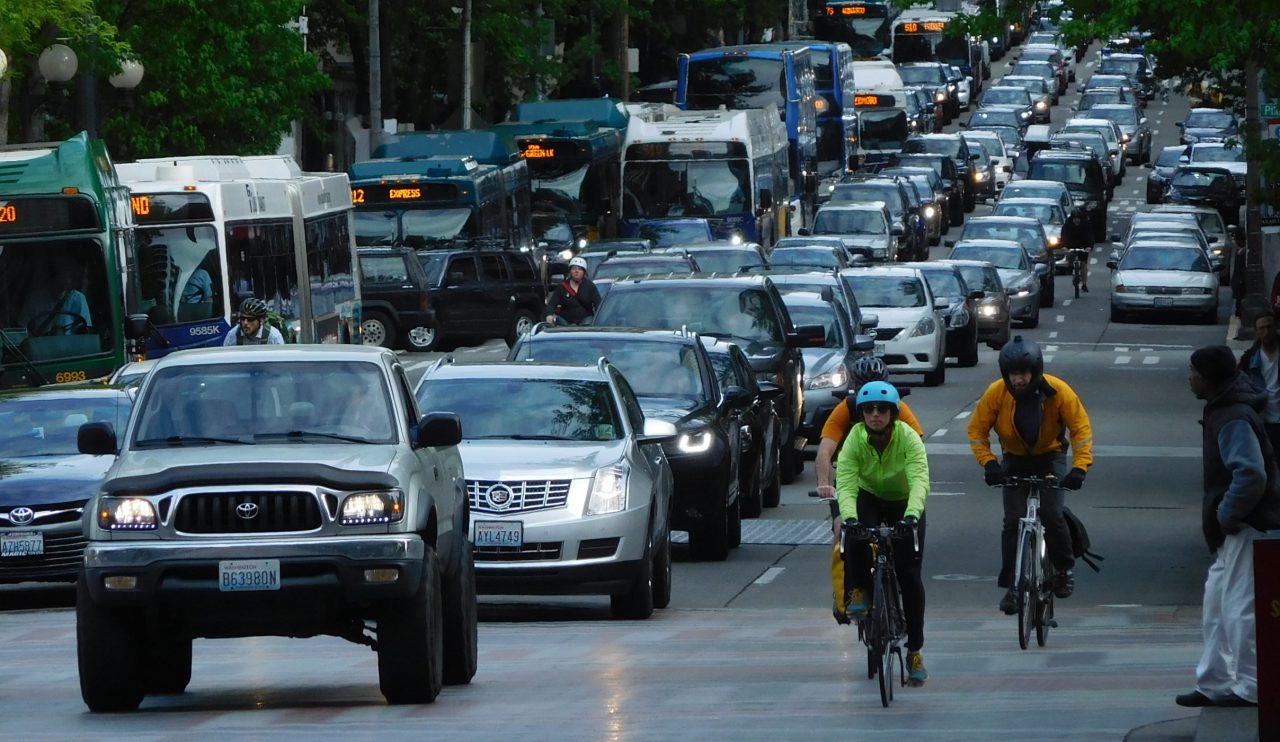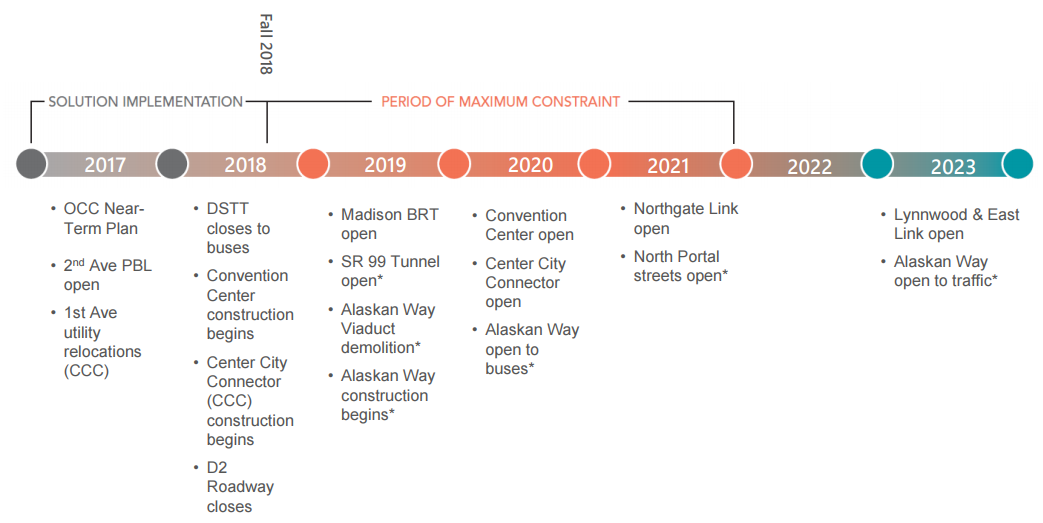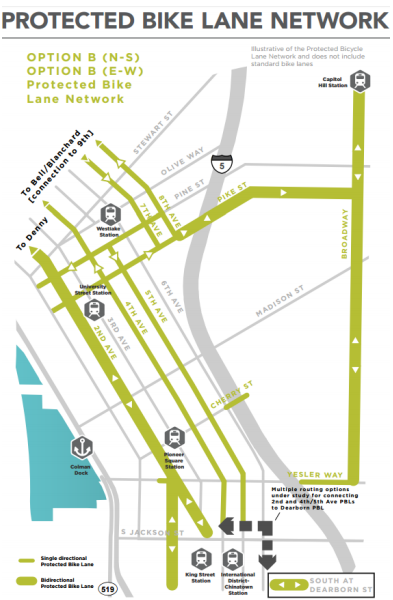
Downtown transportation impacts loom large as policymakers grapple with the appropriate size of the Washington State Convention Center (WSCC) Addition’s public benefits package. One Center City is the project intended to rescue Downtown Seattle from big traffic delays when Addition construction displaces commuter buses out of the Downtown Seattle Transit Tunnel. Without intervention, King County Metro Transit’s operations costs are expected to rise $8 million per year due to increased congestion slowing southbound commutes by at least three minutes and northbound by at least five minutes. So, as the WSCC appears to be lowballing the Community Package Coalition’s desired package by about $50 million, there’s a strong case the WSCC should also contribute to mitigating transit impacts. Note, the City of Seattle valued the initial benefits package at around $20 million.
Meanwhile, fixing the impacts caused by kicking buses out of the tunnel is going to be costly. One Center City’s Option D, which is projected to hold operation costs flat, would cost about $28 million to implement, according to initial reports. The result would be bus-only lanes (peak only) on Fifth Avenue, which could be a big long-term win for Downtown transit. Going big could take this crisis and turn it into an opportunity to transform our transit network for the better. The question is where to get the money to build it and how to execute such an ambitious plan on a condensed schedule. So far, there has been little indication that the WSCC would pay for the transit impacts of its project nor delay their project to reduce those impacts. Nonetheless, chipping into One Center City is a surefire way for the WSCC to demonstrate its commitment to public benefits.
Options Presented For One Center City
| Option | Capital Cost | Increase in Operating Cost Per Year | Description |
|---|---|---|---|
| A | 0 | $8 million | Does nothing |
| B | $11-$15 million | $2.5 million | Off-board payment on Third Avenue; Signal timing on Second & Fourth Avenue |
| C | $14-17 million | $1 million | Adds additional transit lane to Fourth Avenue & a new transit lane on Fifth Avenue |
| D | $28 million | $0 | Turns Fifth Avenue into a transit street between Stewart to Jackson |
The WSCC has argued that the buses will be coming out of the transit tunnel anyway due to the demands of more frequent light rail service as Link expands to Northgate by 2021. That does appear to be Sound Transit’s plan, but there certainly is a cost in doing so a few years earlier and rushing the time transit agencies have to vet and carry out this massive undertaking. Will the transit agencies be able to execute an ambitious plan when they have only 18 months to take the project from early concepts to 100% design?
King County Executive Dow Constantine tried to sell the proposed sale of Convention Place Station for $161 million (which would cement the loss of bus access to the transit tunnel) as a win for Metro Transit because it will funnel the proceeds into transit service. “King County appears to be loaning WSCC the funds to buy the site from itself: a net total of $275 million is expected in principal and interest payments over 32 years. The proceeds will go to improving Metro’s transit service and reliability,” Scott Bonjukian wrote. Of course, one could also view the deal as King County getting fair market value for the prime Downtown site and see the WSCC–as a public facilities district–still having an obligation to mitigate the transportation impacts of its construction.

Some have suggested the best way the WSCC could help Downtown transportation is to simply delay their time table so that the light rail network has a chance to get ahead of impacts to Downtown streets. Starting construction on the addition two years later would mean buses would be removed from the Downtown transit tunnel only once Northgate Link service testing and East Link construction makes it absolutely necessary. The East Link construction apparently will force I-90 buses out of the tunnel in late 2018, but it seems that could potentially be temporary with the East Link itself not operating (and fully kicking buses out) until 2023. And Northgate Link service testing would mean light rail service all the way to North Seattle will be only a few months behind–and with it an easing of pressure on the transit network.


The WSCC Addition’s public benefits package does address some concerns about bike mobility. It’s clear developers envision Pike and/or Pine Street as a bike route. It’s less clear how they plan to make that vision reality and make it truly a safe and comfortable route. There’s a freeway to contend with after all, and that means busy on- and off-ramps that have been the sites of numerous collisions. Ryan Packer lays out the shortcomings of One Center City’s bicycle and pedestrian planning thus far here.
What this leaves us with is an ambitious $1.6 billion convention center expansion plan barreling towards construction with a transportation mitigation strategy that seems entirely a question mark. Perhaps it’s time to ask why the haste? If partner agencies don’t get One Center City right, it will be Seattle area commuters who will be doing the waiting and Metro Transit who will bear the cost of slower buses.
The next Seattle Design Commission hearing on public benefits is on April 20th at 9am in Room L2-80. Update: The WSCC is no longer on the agenda for the April commission meeting, with the South Lander Street Bridge taking its place. The next scheduled Seattle Design Commission meeting is May 4th. The WSCC appears to be hoping its public benefits package will earn the commission’s stamp of approval at its next hearing. The King County Council is also expected to do a hearing on whether or not to approve the Convention Place Station sale on April 26th.
The featured image is by Scott Bonjukian.
Doug Trumm is publisher of The Urbanist. An Urbanist writer since 2015, he dreams of pedestrian streets, bus lanes, and a mass-timber building spree to end our housing crisis. He graduated from the Evans School of Public Policy and Governance at the University of Washington in 2019. He lives in Seattle's Fremont neighborhood and loves to explore the city by foot and by bike.


